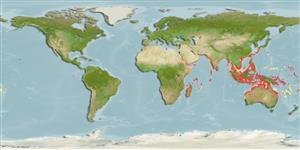Common names from other countries
Environment: milieu / climate zone / depth range / distribution range
Écologie
marin; eau douce; saumâtre démersal; pH range: 7.0 - 8.0; dH range: 9 - 19; amphidrome (Ref. 51243). Tropical; 22°C - 28°C (Ref. 2060)
IIndo-Pacific: from Reunion I., India, and Bangladesh to the Philippines, Indonesia, Thailand, Vietnam, Cambodia, Papua New Guinea, Australia and the Solomon Is.
Taille / Poids / Âge
Maturity: Lm ? range ? - ? cm
Max length : 15.0 cm TL mâle / non sexé; (Ref. 6802); poids max. publié: 18.95 g (Ref. 124712)
Épines dorsales (Total) : 7; Rayons mous dorsaux (Total) : 8; Épines anales: 1; Rayons mous anaux: 8 - 9. Dark longitudinal lines on body; caudal fin black with light margin dorsally; pectoral base with 1-2 black spots (Ref. 5493).
Inhabits brackish mangrove estuaries and lower reaches of freshwater streams, usually on mud bottoms (Ref. 44894). Usually found in lagoons and estuaries, particularly where there is vegetation (Ref. 6028, 79840). Occurs frequently in mangrove swamps (Ref. 2847, 79840). Occasionally ascends rivers (Ref. 6028). Feeds mainly on small fishes and crustaceans (Ref. 6028, 79840). Marketed fresh (Ref. 12693).
Life cycle and mating behavior
Maturities | Reproduction | Spawnings | Egg(s) | Fecundities | Larves
Keith, P. and M.I. Mennesson, 2023. Review of Butis (Teleostei: Butidae) from Indo-Pacific islands with description of three new species. Cybium 47(4):431-466. (Ref. 130228)
Statut dans la liste rouge de l'IUCN (Ref. 130435)
CITES (Ref. 128078)
Not Evaluated
Menace pour l'homme
Harmless
Utilisations par l'homme
Pêcheries: intérêt commercial mineur
Outils
Articles particuliers
Télécharger en XML
Sources Internet
Estimates based on models
Preferred temperature (Ref.
115969): 24.7 - 29.1, mean 28.2 (based on 1196 cells).
Phylogenetic diversity index (Ref.
82804): PD
50 = 0.5156 [Uniqueness, from 0.5 = low to 2.0 = high].
Bayesian length-weight: a=0.00575 (0.00231 - 0.01432), b=3.07 (2.85 - 3.29), in cm Total Length, based on LWR estimates for this (Sub)family-body shape (Ref.
93245).
Niveau trophique (Ref.
69278): 4.0 ±0.66 se; based on food items.
Résilience (Ref.
120179): Haut, temps minimum de doublement de population inférieur à 15 mois (Preliminary K or Fecundity.).
Fishing Vulnerability (Ref.
59153): Low vulnerability (10 of 100).
